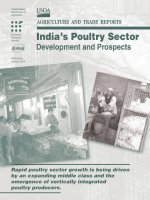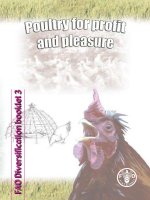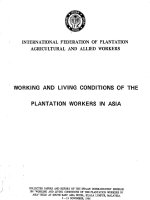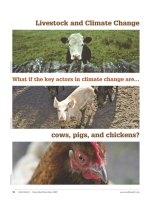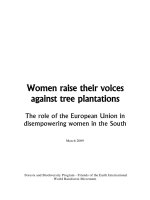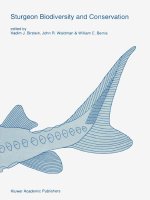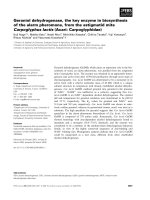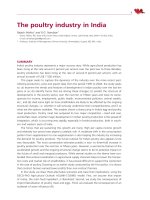Livestock and Climate Change What if the key actors in climate change are…cows, pigs, and chickens? docx
Bạn đang xem bản rút gọn của tài liệu. Xem và tải ngay bản đầy đủ của tài liệu tại đây (718.18 KB, 10 trang )
10 World Wa tch
|
November/December 2009 www.worldwatch.org
Livestock and Climate Change
What if the key actors in climate change are…
cows, pigs, and chickens?
Philip MacKenzie
Duncan Rawlinson © Lyle Rosbotham
by Robert Goodland and Jeff Anhang
W
henever the causes of climate change are discussed, fossil
fuels top the list. Oil, natural gas, and especially coal are indeed
major sources of human-caused emissions of carbon dioxide
(CO
2
) and other greenhouse gases (GHGs). But we believe that
the life cycle and supply chain of domesticated animals raised
for food have been vastly underestimated as a source of GHGs,
and in fact account for at least half of all human-caused
GHGs. If this argument is right, it implies that replacing live-
stock products with better alternatives would be the best strat-
egy for reversing climate change. In fact, this approach would
have far more rapid effects on GHG emissions and their
atmospheric concentrations—and thus on the rate the cli-
mate is warming—than actions to replace fossil fuels with
renewable energy.
Livestock are already well-known to contribute to GHG
emissions. Livestock’s Long Shadow, the widely-cited 2006
report by the United Nations Food and Agriculture Organi-
zation (FAO), estimates that 7,516 million metric tons per
year of CO
2
equivalents (CO
2
e), or 18 percent of annual
worldwide GHG emissions, are attributable to cattle, buffalo,
sheep, goats, camels, horses, pigs, and poultry. That amount
would easily qualify livestock for a hard look indeed in the
search for ways to address climate change. But our analysis
shows that livestock and their byproducts actually account
for at least 32,564 million tons of CO
2
e per year, or 51 percent
of annual worldwide GHG emissions.
This is a strong claim that requires strong evidence, so
we will thoroughly review the direct and indirect sources of
GHG emissions from livestock. Some of these are obvious
but underestimated, some are simply overlooked, and some
are emissions sources that are already
counted but have been assigned to the
wrong sectors. Data on livestock vary from
place to place and are affected by unavoid-
able imprecision; where it was impossible to
avoid imprecision in estimating any sum of
GHGs, we strove to minimize the sum so
our overall estimate could be understood
as conservative.
The Big Picture
The table to the right summarizes the cat-
egories of livestock-based emissions and
our estimates of their size. We begin with the
FAO’s 7,516 million tons of CO
2
e per year
attributable to livestock, an amount estab-
lished by adding up GHG emissions
involved in clearing land to graze livestock
and grow feed, keeping livestock alive, and
processing and transporting the end prod-
ucts. We show that 25,048 million tons of
CO
2
e attributable to livestock have been
undercounted or overlooked; of that subtotal, 3,000 million
tons are misallocated and 22,048 million tons are entirely
u
ncounted. When uncounted tons are added to the global
inventory of atmospheric GHGs, that inventory rises from
41,755 million tons to 63,803 million tons. FAO’s 7,516 mil-
lion tons of CO
2
e attributable to livestock then decline from
18 percent of worldwide GHGs to 11.8 percent. Let’s look at
each category of uncounted or misallocated GHGs:
Breathing. The FAO excludes livestock respiration from
its estimate, per the following argument:
Respiration by livestock is not a net source of CO
2
….
Emissions from livestock respiration are part of a rap-
idly cycling biological system, where the plant matter
consumed was itself created through the conversion of
atmospheric CO
2
into organic compounds. Since the
emitted and absorbed quantities are considered to be
equivalent, livestock respiration is not considered to be
a net source under the Kyoto Protocol. Indeed, since
part of the carbon consumed is stored in the live tis-
sue of the growing animal, a growing global herd could
even be considered a carbon sink. The standing stock
livestock biomass increased significantly over the last
decades…. This continuing growth…could be con-
sidered as a carbon sequestration process (roughly esti-
mated at 1 or 2 million tons carbon per year).
But this is a flawed way to look at the matter. Examining
the sequestration claim first: Sequestration properly refers to
extraction of CO
2
from the atmosphere and its burial in a vault
or a stable compound from which it cannot escape over a
long period of time. Even if one considers the standing mass
of livestock as a carbon sink, by the FAO’s own estimate the
amount of carbon stored in livestock is trivial compared to the
www.worldwatch.org November/December 2009
|
World Wa tch 11
Annual GHG Percentage of
emissions (CO
2
e) worldwide total
million tons
FAO estimate 7,516 11.8
Uncounted in current GHG inventories:
1. Overlooked respiration by livestock 8,769 13.7
2. Overlooked land use ≥ 2,672 ≥ 4.2
3. Undercounted methane 5,047 7.9
4. Other four categories (see text) ≥ 5,560 ≥ 8.7
Subtotal ≥ 22,048 ≥ 34.5
Misallocated in current GHG inventories:
5. Three categories (see text) ≥ 3,000 ≥ 4.7
Total GHGs attributable to
livestock products ≥ 32,564 ≥ 51.0
Uncounted, Overlooked, and Misallocated
Livestock-related GHG Emissions
12 World Wa tch
|
November/December 2009 www.worldwatch.org
amount stored in forest cleared to create space for growing feed
and grazing livestock.
More to the point, livestock (like automobiles) are a
human invention and convenience, not part of pre-human
times, and a molecule of CO
2
exhaled by livestock is no
more natural than one from an auto tailpipe. Moreover,
while over time an equilibrium of CO
2
may exist between the
amount respired by animals and the amount photosynthe-
sized by plants, that equilibrium has never been static. Today,
tens of billions more livestock are exhaling CO
2
than in pre-
industrial days, while Earth’s photosynthetic capacity (its
capacity to keep carbon out of the atmosphere by absorbing
it in plant mass) has declined sharply as forest has been
cleared. (Meanwhile, of course, we add more carbon to the
air by burning fossil fuels, further overwhelming the carbon-
absorption system.)
The FAO asserts that livestock respiration is not listed as a
recognized source of GHGs under the Kyoto Protocol, although
in fact the Protocol does list CO
2
with no exception, and “other”
is included as a catchall category. For clarity, it should be listed
separately in whatever protocol replaces Kyoto.
It is tempting to exclude one or another anthropogenic
source of emissions from carbon accounting—according to
one’s own interests—on the grounds that it is offset by pho-
tosynthesis. But if it is legitimate to count as GHG sources
fossil-fuel-driven automobiles, which hundreds of millions of
people do not drive, then it is equally legitimate to count live-
stock respiration. Little or no livestock product is consumed by
hundreds of millions of humans, and no livestock respiration
(unlike human respiration) is needed for human survival. By
keeping GHGs attributable to livestock respiration off GHG
balance sheets, it is predictable that they will not be managed
and their amount will increase—as in fact is happening.
Carbon dioxide from livestock respiration accounts for 21
percent of anthropogenic GHGs worldwide, according to a
2005 estimate by British physicist Alan Calverd. He did not
provide the weight of this CO
2
, but it works out to about
8,769 million tons. Calverd’s estimate is the only original esti-
mate of its type, but because it involves only one variable (the
total mass of all livestock, as all but cold-blooded farmed fish
exhale roughly the same amount of CO
2
per kilogram), all cal-
culations of CO
2
from the respiration of a given weight of
livestock would be about the same.
Calverd’s estimate did not account for the fact that CO
2
from livestock respiration is excluded from global GHG inven-
tories. It also did not account for the GHGs newly attributed
to livestock in our analysis. After adding all relevant GHGs to
global GHG inventories, the percentage of GHGs attributable
to livestock respiration drops from 21 percent to 13.7 percent.
Land. As there is now a global shortage of grassland, prac-
tically the only way more livestock and feed can be produced
Cows respire on a cold morning at a cattle market in Buenos Aires, Argentina.
Beatrice Murch
is by destroying natural forest. Growth in markets for livestock
products is greatest in developing countries, where rainforest
normally stores at least 200 tons of carbon per hectare. Where
forest is replaced by moderately degraded grassland, the ton-
nage of carbon stored per hectare is reduced to 8.
On average, each hectare of grazing land supports no
more than one head of cattle, whose carbon content is a frac-
tion of a ton. In comparison, over 200 tons of carbon per
hectare may be released within a short time after forest and
other vegetation are cut, burned, or chewed. From the soil
beneath, another 200 tons per hectare may be released, with
yet more GHGs from livestock respiration and excretions.
Thus, livestock of all types provide minuscule carbon “pig-
gybanks” to replace huge carbon stores in soils and forests. But
if the production of livestock or crops is ended, then forest will
often regenerate. The main focus in efforts to mitigate GHGs
has been on reducing emissions, while—despite its ability to
mitigate GHGs quickly and cheaply—vast amounts of poten-
tial carbon absorption by trees has been foregone.
The FAO counts emissions attributable to changes in land
use due to the introduction of livestock, but only the relatively
small amount of GHGs from changes each year. Strangely, it
does not count the much larger amount of annual GHG reduc-
tions from photosynthesis that are foregone by using 26 per-
cent of land worldwide for grazing livestock and 33 percent of
arable land for growing feed, rather than allowing it to regen-
erate forest. By itself, leaving a significant amount of tropical
land used for grazing livestock and growing feed to regenerate
as forest could potentially mitigate as much as half (or even
more) of all anthropogenic GHGs. A key reason why this is not
happening is that reclaiming land used for grazing livestock and
growing feed is not yet a priority; on the contrary, feed pro-
duction and grazing have been fast expanding into forest.
Or suppose that land used for
grazing livestock and growing feed
w
ere used instead for growing
crops to be converted more
directly to food for humans and to
biofuels. Those fuels could replace
one-half of the coal used world-
wide, which is responsible for
about 3,340 million tons of CO
2
e
emissions every year. That ton-
nage represents 8 percent of
GHGs in worldwide GHG inven-
tories that omit the additional
GHGs assessed by this article, or
5.6 percent of GHGs worldwide
when the GHGs assessed in this
article are included. If biomass
feedstocks are chosen and
processed carefully, then biofuels
can yield 80 percent less GHGs
per unit of energy than coal. Therefore, the extra emissions
resulting from using land for livestock and feed can be esti-
mated to be 2,672 million tons of CO
2
e, or 4.2 percent of
annual GHG emissions worldwide.
Considering these two plausible scenarios, at least 4.2 per-
cent of worldwide GHGs should be counted as emissions
attributable to GHG reductions foregone by using land to
graze livestock and grow feed.
Methane. According to the FAO, 37 percent of human-
induced methane comes from livestock. Although methane
warms the atmosphere much more strongly than does CO
2
,
its half-life in the atmosphere is only about 8 years, versus at
least 100 years for CO
2
. As a result, a significant reduction in
livestock raised worldwide would reduce GHGs relatively
quickly compared with measures involving renewable energy
and energy efficiency.
The capacity of greenhouse gases to trap heat in the atmos-
phere is described in terms of their global warming potential
(GWP), which compares their warming potency to that of
CO
2
(with a GWP set at 1). The new widely accepted figure
for the GWP of methane is 25 using a 100-year timeframe—
but it is 72 using a 20-year timeframe, which is more appro-
priate because of both the large effect that methane reductions
can have within 20 years and the serious climate disruption
expected within 20 years if no significant reduction of GHGs
is achieved. The Intergovernmental Panel on Climate Change
supports using a 20-year timeframe for methane.
The FAO estimates that livestock accounted for 103 mil-
lion tons of methane emissions in 2004 through enteric fer-
mentation and manure management, equivalent to 2,369
million tons of CO2e. This is 3.7 percent of worldwide GHGs
using, as FAO does, the outdated GWP of 23. Using a GWP
of 72, livestock methane is responsible for 7,416 million
tons of CO
2
e or 11.6 percent of worldwide GHGs. So using
www.worldwatch.org November/December 2009
|
World Wa tch 13
A Kansas feedlot operation with waste management lagoon in the foreground.
USDA/NRCS, Jeff Vanuga
14 World Wa tch
|
November/December 2009 www.worldwatch.org
the appropriate timeframe of 20
years instead of 100 years for
m
ethane raises the total amount
of GHGs attributable to livestock
products by 5,047 million tons of
CO
2
e or 7.9 percentage points.
(Further work is needed to recal-
ibrate methane emissions other
than those attributable to live-
stock products using a 20-year
timeframe.)
Other sources. Four additional
categories of GHGs adding up to
at least 5,560 million tons of CO
2
e
(8.7 percent of GHGs emissions)
have been overlooked or under-
counted by the FAO and
uncounted in the existing inven-
tory of worldwide GHGs:
First, Livestock’s Long Shadow
cites 2002 FAO statistics as the key
source for its 18-percent estimate.
From 2002 to 2009, the tonnage of livestock products world-
wide increased by 12 percent, which must yield a propor-
tional increase in GHG emissions. Through extrapolation
from the FAO’s estimate as well as our own, we calculate that
the increase in livestock products worldwide from 2002 to
2009 accounts for about 2,560 million tons of CO
2
e, or 4.0 per-
cent of GHG emissions.
Second, the FAO and others have documented frequent
undercounting in official statistics of both pastoral and indus-
trial livestock. Livestock’s Long Shadow not only uses no cor-
rection factor for such undercounting, but in some sections
actually uses lower numbers than appear in FAO statistics
and elsewhere. For example, Livestock’s Long Shadow reports
that 33.0 million tons of poultry were produced worldwide in
2002, while FAO’s Food Outlook of April 2003 reports that
72.9 million tons of poultry were produced worldwide in
2002. The report also states that 21.7 billion head of livestock
were raised worldwide in 2002, while many nongovernmen-
tal organizations report that about 50 billion head of live-
stock were raised each year in the early 2000s. If the true
number is closer to 50 billion than to 21.7 billion, then the per-
centage of GHGs worldwide attributable to undercounting in
official livestock statistics would likely be over 10 percent.
Third, the FAO uses citations for various aspects of GHGs
attributable to livestock dating back to such years as 1964, 1982,
1993, 1999, and 2001. Emissions today would be much higher.
Fourth, the FAO cites Minnesota as a rich source of data.
But if these data are generalized to the world then they under-
state true values, as operations in Minnesota are more efficient
than operations in most developing countries where the live-
stock sector is growing fastest.
Finally, we believe that FAO has overlooked some emis-
sions that have been counted under sectors other than live-
stock. These emissions add up to at least 3,000 million tons of
CO
2
e, or 4.7 percent of GHG emissions worldwide.
First, the FAO states that “livestock-related deforestation
as reported from, for example, Argentina is excluded”from its
GHG accounting. Second, the FAO omits farmed fish from its
definition of livestock and so fails to count GHGs from their
life cycle and supply chain. It also omits GHG emissions from
portions of the construction and operation of marine and
land-based industries dedicated to handling marine organisms
destined to feed livestock (up to half the annual catch of
marine organisms).
Lastly, the FAO leaves uncounted the substantially higher
amount of GHGs attributable to each of the following aspects
of livestock products versus alternatives to livestock products:
•
Fluorocarbons (needed for cooling livestock products much
more than alternatives), which have a global warming poten-
tial up to several thousand times higher than that of CO
2
.
•
Cooking, which typically entails higher temperatures and
longer periods for meat than alternatives, and in developing
countries entails large amounts of charcoal (which reduces
carbon absorption by consuming trees) and kerosene, each
of which emits high levels of GHGs.
•
Disposal of inevitably large amounts of liquid waste from live-
stock, and waste livestock products in the form of bone, fat,
and spoiled products, all of which emit high amounts of
GHGs when disposed in landfills, incinerators, and waterways.
•
Production, distribution, and disposal of byproducts, such
as leather, feathers, skin, and fur, and their packaging.
•
Production, distribution, and disposal of packaging used
for livestock products, which for sanitary reasons is much
Adding more to the carbon footprint: large fans keep pigs cool in North Carolina.
USDA/NRCS, Bob Nichols
more extensive than for alternatives to livestock products.
•
Carbon-intensive medical treatment of millions of cases
worldwide of zoonotic illnesses (such as swine flu) and
chronic degenerative illnesses (such as coronary heart disease,
cancers, diabetes, and hypertension leading to strokes) linked
to the consumption of livestock products. Full accounting of
GHGs attributable to livestock products would cover portions
of the construction and operation of pharmaceutical and
medical industries used to treat these illnesses.
Mitigation
A key risk factor for climate change is the growth of the human
population, projected to be roughly 35 percent between 2006
and 2050. In the same period, the FAO projects that the num-
ber of livestock worldwide will double, so livestock-related
GHG emissions would also approximately double (or rise
slightly less if all the FAO’s recommendations were fully imple-
mented), while it is widely expected that GHGs from other
industries will drop. This would make the amount of live-
stock-related emissions even more unacceptable than today’s
perilous levels. It also means that an effective strategy must
involve replacing livestock products with better alternatives,
rather than substituting one meat product with another that
has a somewhat lower carbon footprint.
A substantial body of theory, beliefs, and even vested inter-
est has been built up around the idea of slowing climate
change through renewable energy and energy efficiency.How-
ever, after many years of international climate talks and prac-
tical efforts, only relatively modest amounts of renewable
energy and energy efficiency have been developed (along with
more nuclear- and fossil-energy infrastructure). GHG emis-
sions have increased since the Kyoto Protocol was signed in
1992 and climate change has accelerated. However desirable,
even major progress in displacing nonrenewable energy would
not obviate substantial action to reduce the huge amounts of
livestock-related GHGs emissions.
Action to replace livestock products not only can achieve
quick reductions in atmospheric GHGs, but can also reverse
the ongoing world food and water crises. Were the recom-
mendations described below followed, at least a 25-percent
reduction in livestock products worldwide could be achieved
between now and 2017, the end of the commitment period to
be discussed at the United Nations’ climate conference in
Copenhagen in December 2009. This would yield at mini-
mum a 12.5-percent reduction in global anthropogenic GHGs
emissions, which by itself would be almost as much reduction
as is generally expected to be negotiated in Copenhagen.
Because of the urgency of slowing climate change, we
believe that recommending change directly to industry will be
more effective than recommending policy changes to gov-
ernments, which may or may not eventually lead to change in
www.worldwatch.org November/December 2009
|
World Wa tch 15
Scene on the factory floor: pigs in production.
Photo courtesy Farm Sanctuary
16 World Wa tch
|
November/December 2009 www.worldwatch.org
industry. This is true even though industry and investors nor-
mally thrive when they are responsive to customers and share-
holders in the short term, while climate seems to pose
longterm risks.
Livestock-related GHGs could be managed by govern-
ments through the imposition of carbon taxes (despite oppo-
sition from the livestock industry), in which case leaders in the
food industry and investors would search for opportunities that
such carbon taxes would help create. In fact, they might seek
to benefit from such opportunities even in the absence of car-
bon taxes because livestock-related GHG emissions are a grave
risk to the food industry itself. Disruptive climate events are
forecast to threaten developed markets increasingly, and to
result in even more harm to emerging markets, where the food
industry is otherwise forecast to achieve its greatest growth.
Opportunity
An individual food company has at least three incentives to
respond to the risks and opportunities applicable to the food
industry at large. The first incentive is that individual food
companies already suffer from disruptive climate events, so a
company’s self-interest might well be served by acting to slow
climate change. In affected areas, disruptive climate events can
be expected to degrade not only the food industry’s markets,
but also its infrastructure and its ability to operate. For exam-
ple, all these risks played out in the New Orleans area in 2005
following Hurricane Katrina, when Whole Foods Market, Inc.
reported US$16.5 million in losses that year due to the closure
of its damaged stores in the New Orleans area, loss of sales, and
renovations at the damaged stores.Such risks will be aggravated
by extreme climate events in the future, which are expected to
occur with increasing frequency and intensity worldwide.
A second incentive stems from the likelihood, once the cur-
rent economic crisis is resolved, that demand for oil will rise
to levels impossible to meet because of a terminal decline in
production (the “peak oil” phenomenon). Petroleum’s price
will spike so high as to bring about the collapse of many parts
of today’s economy. Livestock products would take an extra
hit because every gram of biofuel from crops that can possi-
bly be produced to replace conventional fuel likely will be
produced—and thereby diverted from livestock—in efforts to
stave off disaster. It has been predicted from within both the
livestock and financial sectors that peak oil could bring about
the collapse of the livestock sector within a few years. To be
ahead of the competition in that scenario is another reason for
leaders in the food industry to begin replacing livestock prod-
ucts with better alternatives immediately.
A third incentive is that a food company can produce
and market alternatives to livestock products that taste sim-
ilar, but are easier to cook, less expensive, and healthier, and
so are better than livestock products. These alternatives are
analogs to livestock products such as soy- and seitan (wheat
gluten) beef, chicken, and pork; and soy- and rice milk,
cheese, and ice cream.
Sales in the United States alone of soy analogs totaled $1.9
billion in 2007, up from $1.7 billion in 2005, according to the
Non-meat meat. Alternative ingredients include textured soy protein, soy lecithin,
brown rice, ground sunflower seeds, mycoprotein, and wheat gluten.
Lyle Rosbotham
Soyfoods Association of North America. In comparison, sales
in the United States of meat products (including poultry)
t
opped $100 billion in 2007. This 1.9 to 100 ratio suggests
much room for growth in sales of meat and dairy analogs.
Meat and dairy analogs are already sold throughout the devel-
oping world, and as in the United States sales have increased
in recent years. So efforts to increase sales of these products
in developing countries do not have to wait for similar efforts
to succeed in the developed world first. Worldwide, the mar-
ket for meat and dairy analogs is potentially almost as big as
the market for livestock products.
Large organic-food companies might
find these opportunities especially appeal-
ing. Such companies could establish sub-
sidiaries to sell meat and dairy analogs,
possibly exclusive of meat or dairy prod-
ucts. They could significantly scale up pro-
duction and sales of analogs within a few
years at a reasonable capital cost and with
an attractive return on investment. And
because meat and dairy analogs are pro-
duced without the GHG-intensive
processes used in raising livestock—such
as animals’ CO
2
and methane emissions,
and usage of land for growing feed and grazing livestock—the
analogs clearly generate a small fraction of the GHGs attrib-
utable to livestock products. So additional revenues might be
captured from the sale of carbon credits for the reduction in
GHG emissions achieved by analogs versus livestock products.
Analogs are most indistinguishable from meat and dairy
products when they are chopped, breaded, sauced, spiced, or
otherwise processed, so among the least risky strategies might
be for a company subsidiary to build a chain of fast-food out-
lets featuring soy burgers, soy chicken products, sandwiches
made with various meat analog products, and/or soy ice
cream. If the chain’s growth were rapid, then other food com-
panies would be tempted to copy from the first mover.
If production of meat and dairy analogs is significantly
increased, then their costs will decline—a key advantage for
at least as long as the present economic recession in many
countries persists. Cost reductions will follow from economies
of scale and increased competition among analog producers,
as well as because the primary feedstock for biodiesel is soy oil.
Meeting the significantly higher forecast demand for biodiesel
will yield surpluses of soy meal, which is not only a byprod-
uct of soy oil but a raw material for many meat and dairy
analogs. Surpluses in stocks of soy meal may drive down its
price significantly.
For consumers who do not like meat and dairy analogs,
protein-rich legumes and grains are readily available alter-
natives. Another option might be artificial meat cultivated in
laboratories from cells originating from livestock, sometimes
called“in vitro”meat. Some experiments have been done and
patents registered, but production and possible commercial-
ization are several years off and it will be awhile before it is
known whether in vitro meat might compete with analogs in
c
ost and taste as well as health and environmental impacts.
Marketing
To achieve the growth discussed above will require a signifi-
cant investment in marketing, especially since meat and dairy
analogs will be new to many consumers. A successful campaign
would avoid negative themes and stress positive ones. For
instance, recommending that meat not be eaten one day per
week suggests deprivation. Instead, the campaign should pitch
the theme of eating all week long a line of food products that
is tasty, easy to prepare, and includes a “superfood,” such as soy,
that will enrich their lives. When people hear appealing mes-
sages about food, they are listening particularly for words
that evoke comfort, familiarity, happiness, ease, speed, low
price, and popularity. Consequently, several other themes
should be tapped to build an effective marketing campaign:
By replacing livestock products with analogs, consumers
can take a single powerful action collectively to mitigate most
GHGs worldwide. Labeling analogs with certified claims of the
amount of GHGs averted can give them a significant edge.
Analogs are less expensive, less wasteful, easier to cook, and
healthier than livestock products.
Meat and dairy analogs can be positioned as clearly supe-
rior to livestock products, thus appealing to the same con-
sumer urges that drive purchases of other analog products,
such as Rolex knockoffs.
In developing countries, where per-capita meat and dairy
consumption is lower than in developed countries, consumers
often see meat and dairy products as part of a better diet and
a better life, and have not yet been informed about their adverse
impacts.Yet meat and dairy analogs can yield even better out-
comes, particularly if they are marketed with such intent.
As shown by the track record of green businesses, the
most appropriate target of the campaign would be environ-
mentalists, on the basis that eating meat and dairy analogs is
the best way to combat climate change. They can be expected
to spread such messages to other people, and may press for
analogs to be served at meetings they attend and for the GHGs
thereby avoided to be well publicized.
Probably most susceptible to messages about new foods
and fast foods are children, who are prone to act on adver-
tising, having less-ingrained habits than adults, and often
seek to catch the wave of a new trend. Parents often join in
eating a fast food meal or other food product that their chil-
dren insist be bought for them. At the same time, children are
being increasingly educated on climate change in school, and
are searching for activities that allow them to experiment
with what they have learned. Yet they are major targets when
it comes to marketing livestock products, despite the griev-
ously high climate risk of those products. To correct this,
consideration should be given to changing applicable stan-
dards for marketing to children. In any event, marketing
www.worldwatch.org November/December 2009
|
World Wa tch 17
18 World Wa tch
|
November/December 2009 www.worldwatch.org
meat and dairy analogs to children should be a priority.
In addition, food companies can market meat and dairy
analogs through strategic alliances with other companies. They
can engage with schools, governments, and nongovernmental
organizations. Environmentalists with relevant skills can be
called upon to conduct ongoing, comprehensive tracking of
GHGs attributable to livestock products and analogs. Politicians
and celebrities can be enlisted to make public pitches for con-
sumers to choose alternatives to livestock products.
We recommend that when grocers plan displays and set
slotting fees (for favorable shelf placement), they consider
the benefits of displaying analogs side by side with meat and
dairy products. This would expose analogs to many con-
sumers who may not otherwise be exposed to them, and
thereby facilitate an increase in their sales. It would permit the
achievement of good sales results that normally occur when
consumers are shown multiple forms of a product on the
same shelf. Where analogs cost less than meat products, dis-
playing one beside the other may have an enhanced benefit for
grocers. That is, if consumers find in a side-by-side compar-
ison that analogs are cheaper than livestock products, then
side-by-side placement may help grocers keep up their over-
all sales volumes in an economic downturn.
Sources of Investment
A company with a sound plan for increasing sales of meat or
dairy analogs is likely to find sufficient commercial financing
available from investors seeking investment opportunities
that promise to help slow climate change. It may also find
concessional financing through development finance insti-
tutions and “climate funds.” But it may need to raise aware-
ness among investors unfamiliar with meat and dairy analogs.
Investors can be shown that it is in their self-interest to
avoid new investments in the production of meat and dairy
products and to seek investments in analogs instead. Com-
pared with power and transportation projects, analog proj-
ects can be implemented quickly, with relatively low levels
of incremental investment, larger amounts of GHGs miti-
gated for the same amount of investment, and faster returns
on investment.
Investments in minimizing and mitigating GHGs most
often focus on renewable energy in the transportation and
power sectors. However, renewable-energy infrastructure has
both long and complex product-development cycles and cap-
ital-intensive requirements. Converting vehicle fleets and
power plants is forecast to cost trillions of dollars, and to
require political will and consensus that do not appear close
at hand. Even if money and politics were up to the task, such
solutions are expected to take more than a decade to imple-
ment fully, by which time the tipping point may long since
have been passed for irreversible climate disruption.
Most commercial banks, some export-credit agencies, and
even some equity funds have adopted the Equator Principles,
by which they commit to complying with a set of rigorous
environmental and social performance standards for invest-
Non-dairy dairy: an array of soy milk options.
Courtesy WhiteWave
ment projects in developing countries. If those standards were
to frown upon investments in large-scale livestock projects,
then a company with a meat or dairy analog project would be
well positioned to attract investments.
Benefit Package
Meat and dairy analog projects will not only slow climate
change but also help ease the global food crisis, as it takes a
much smaller quantity of crops to produce any given number
of calories in the form of an analog than a livestock product.
Analogs would also alleviate the global water crisis, as the
huge amounts of water necessary for livestock production
would be freed up. Health and nutritional outcomes among
consumers would be better than from livestock products.
Analog projects would be more labor intensive than livestock
projects, so would create both more jobs and more skilled
jobs. They would also avert the harmful labor practices found
in the livestock sector (but not in analog production), includ-
ing slave labor in some areas such as the Amazon forest region.
Workers producing livestock products can easily be retrained
to produce analogs.
Of course, some livestock will continue to be raised, espe-
cially where they are important in mixed farming systems.
They may also be important where raising livestock is one of
the few ways for poor rural populations to create assets and
earn income. However, that is increasingly less common, as the
dramatic growth in recent years in the use of computers,
mobile communications, mobile banking,
microfinance, and off-grid electricity has cre-
a
ted a multitude of new opportunities for
poor rural communities.
For many years, advocacy of alternatives
to livestock products has been based on argu-
ments about nutrition and health, compas-
sion for animals, and environmental issues
other than carbon intensity. These arguments
have mostly been ignored and the consump-
tion of livestock products worldwide has
increased, leading some to believe that such
advocacy may never succeed. Even urging
governments to mandate reductions in live-
stock production on grounds of climate
change may prove ineffective because of the
food industry’s own large lobbying capacity.
But if the business case for meat and dairy
analogs is clear, then those who normally
would lobby governments can appeal directly
to leaders in the food industry, who may wel-
come them as champions. The business risks
of analog projects would be similar to those
in most other food manufacturing projects,
but the risks would be mitigated by the fact
that much of the necessary infrastructure
(such as for growing and processing grains) already exists.
The key change would be a significant reduction in live-
stock products. Industry-led or supply-led growth has been
successful in other industries, such as the computer and
mobile-phone industries, which suggests that it can be suc-
cessful with meat and dairy analogs. Generally, the food indus-
try worldwide has a very sophisticated marketing capacity,
making high growth from marketing new food products prac-
tically a norm —even before one considers the extra lift that
might be achieved from interest in slowing climate change.
The risks of business as usual outweigh the risks of change.
The case for change is no longer only a public policy or an eth-
ical case, but is now also a business case. We believe it is the
best available business case among all industries to reverse
climate change quickly.
Robert Goodland retired as lead environmental adviser at
the World Bank Group after serving there for 23 years. In
2008 he was awarded the first Coolidge Memorial Medal by
the IUCN for outstanding contributions to environmental
conservation. Jeff Anhang is a research officer and environ-
mental specialist at the World Bank Group’s International
Finance Corporation, which provides private-sector financing
and advice in developing countries.
www.worldwatch.org November/December 2009
|
World Wa tch 19
For more information about issues raised in this story, visit
www.worldwatch.org/ww/livestock.
The mighty analog: soybeans await harvest on a Maryland farm.
Scott Robinson


